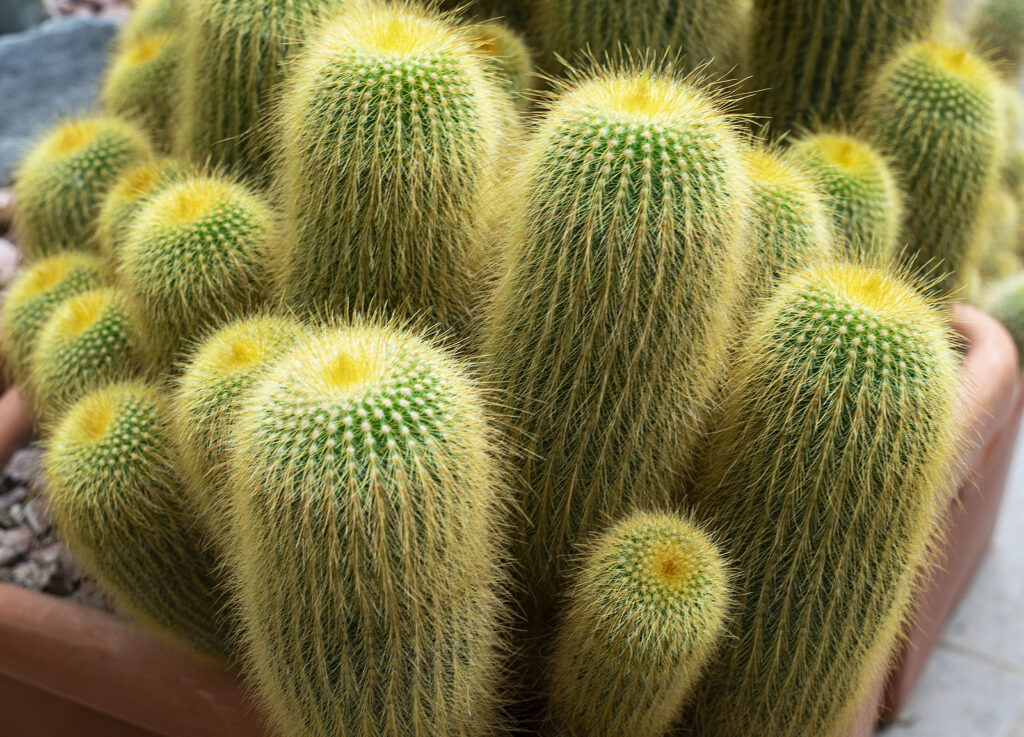Notocactus are usually globular cacti commonly known as ball cactus. There are also some columnar-shaped Notocactus. Most plants are round when young, but become columnar with age.
Notocactus can grow to 2 feet tall, but most are much smaller, just a few inches tall. Notocactus have many grooved ribs. They also bear numerous flowers–usually yellow, sometimes red–from the crown of the plant.
Notocactus are easy to grow. They will grow and bloom indoors under bright light. A flowering season from spring through summer produces bright yellow blooms, tinged with red on the outer petals. Notocactus generally do not want direct sunlight.
About 25 species make up this genus of small cacti. Notocactus have recently been included in the Parodia genus. Notocactus are native to South America.
Notocactus are best suited as a windowsill or table plant.
Get to know Notocactus
- Plant type:
- Hardiness temperature: 30℉ (-1.1℃)
- Optimal growing temperature: day, 70°F (21°C); night, 50° to 55°F (10° to 13°C.
- Shape and size: globular or cylindrical bodies with many grooved ripes; grows to 24 inches (61cm) tall
- Flowers: Multiple yellow (sometimes red) flowers borne from the crown of the plant
- Bloom time: Spring and summer
- Common name: Ball cactus
- Genus name: Notocactus
- Family name: Cactaceae
- Origin: South America

Planting Notocactus
- Grow Notocactus where is is warm and sunny, but not in full sun. Notocactus will grow in half shade.
- Indoors Notocactus needs bright, filtered light, with 4 hours direct sun daily, from southern, southeastern, or eastern exposure. Does well under artificial light, needing 12 light-hours daily. Air circulation is important.
- Grow Notocactus in sandy, mhumous, slightly acidic, porous soil; the soil must be well-drained.
How to water and feed Notocactus
- Water Notocactus regularly during the summer growing season; let the soil dry between waterings.
- Allow the soil to dry during the winter dormant period.
- Feed Notocactus every 6 weeks during growing season, with full strength low-nitrogen, high-potassium fertilizer
Notocactus care
- Pot-on Notocactus when the roots completely overcrowd pot space.
- Check for aphids, mealybugs, spider mites, scale. Also be alert for fungus disease.
- Let Notocactus rest during winter. Keep cool, 50°F (10°C). Water only enough to keep the plant from drying out completely; withhold fertilizer.
- Propagate Notocactus by seed or offsets.
Notocactus species to grow
- Notocactus apricus (sun cup). Globular stem with 15 to 20 nearly flat ribs that will eventually form a clump; grows to 3 inches (8 cm) with a 2-inch (5 cm) spread; yellow radial spines that contrast with curved, reddish, central ones; yellow flowers appear on 3-inch-long stout tubes from the crown.
- N. brevihamata (Parodia brevihamata). Species with golden yellow flowers.
- N. concinnus. Grows to 3 inches (8 cm) with a 4-inch (10 cm) spread; has a light green stem, slightly depressed at the top, with 18 notched ribs.
- N. hasselbergii (scarlet ball). Slow grower to 5 inches (13 cm) tall and wide; body covered with soft white spines; small, reddish-orange flowers are long-lasting, sometimes up to 4 weeks.
- N. leninghausil (golden ball). One of the largest ball cacti grows to 3 feet tall with 30 or more ribs; becomes elongated and cylindrical with age, and the top appears to tilt to one side; large yellow flowers appear on mature plants.
- N. ottonis (Indian head). Clustering, globular plant with bristly, reddish-brown spines and bright yellow flowers. Varieties include ‘Tenuispinus’ and ‘Longispinus’.
- N. scopa (silver ball). Globular, heavily ribbed ball covered with silvery-white, soft spines; two-inch-wide, deep yellow flowers.















